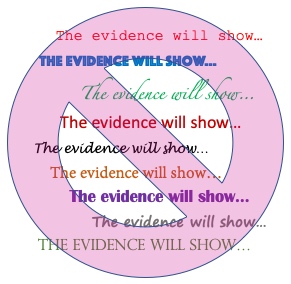By Dr. Ken Broda Bahm:

Unlike many other moments in trial, the opening statement is often defined in terms of what it isn’t. It isn’t evidence, and it isn’t argument. So, what is it? It is a preview of what the evidence will be. That creates a conventional practice, reinforced in nearly all trial advocacy courses and moot court competitions: When delivering an opening statement, precede your claims with the phrase, “The evidence will show….” Some believe that this functionally is required, and there are at least a few judges who will act as though it is. But not all judges believe that.
One federal judge, Robert Lasnik, the senior judge in the Western District of Washington, says attorneys are better off dropping it. “My first bit of advice,” he writes in a recent column carried by Jury Matters, “would be to delete the phrases ‘The evidence will show’ and ‘We expect the evidence will show’ from your statement.” It is a convention that sounds legalistic and can quickly become redundant or meaningless. But more than that, it interferes with a direct and streamlined answer to the question that jurors are most interested in at this stage of the trial: “What happened?” Telling a story means not just reciting a checklist of what you plan to prove at a later point. It means immersing your judge or jurors in the narrative. So the best rule of thumb is this: Use it if you’re required to use it, but whenever you aren’t required to use the phrase, or whenever you can get away with using it just a couple of times at the beginning and then dropping it, you should do so.
Cut the Use of “The Evidence Will Show”
The rules require that you avoid the presentation of evidence and explicit argument, but the rules do not require the repetitive use of the magic words, “the evidence will show” as a guard against that. Given that, there are a number of reasons why trial lawyers should give it up.
Because It Interrupts
Any repeated phrase, especially a legalistic-sounding one like, “the evidence will show” is an interference. Judge Lasnik notes, “When else will you have a chance to capture the jury’s attention, present an uninterrupted version of the facts, and highlight those parts of the case that you want them to listen to and look for as the case progresses?”
Because It Interferes with the Story
Judge Lasnik argues that the words “do nothing but break the flow of what should be a unique opportunity to set the stage for the jury.” He continues, “Remember that for most of their lives, jurors get information in narrative form from dramatic presentations in movies or television shows or from reading articles or novels: a good narrative has great impact.” After all, when we hear a story, we don’t hear “This story will tell you…,” we just hear the story.
Because It Creates Distance
When you’re introducing your case, you want jurors to be in the moment. The phrase “the evidence will show,” however, is a reference to another time. It is a way of saying, “You can deal with this later,” or even “Don’t believe me now, wait and think about it then.”
Because They’ve Already Been Told
It is all but certain that before either attorney gets up to deliver their opening statement, the jurors have been told about the function of the opening statement, and the fact that what the attorneys are saying is not evidence. So why interrupt the flow of the story by telling them again and again? In fact, if you do have a judge who believes in the phrase, this might be a good argument: “Your honor, I am trusting that you will have already instructed the jury on this point prior to opening, and I am further trusting that the jurors will understand, remember, and follow that instruction.”
Yes, with any luck, “the evidence will show” that what you’re laying out is supported, and jurors know not to reach a final decision until they hear that evidence. But in the meantime, they just want to hear your story. So cut the clutter and present your preview in a clear, direct, and persuasive way.
_______
Other Posts on Opening Statement:
- Stop Introducing Your Defense Case By Asking Jurors to Set Aside Sympathy
- Right Out of the Blocks: Make the First Few Minutes Count
- Chunk Your Trial Message
_______